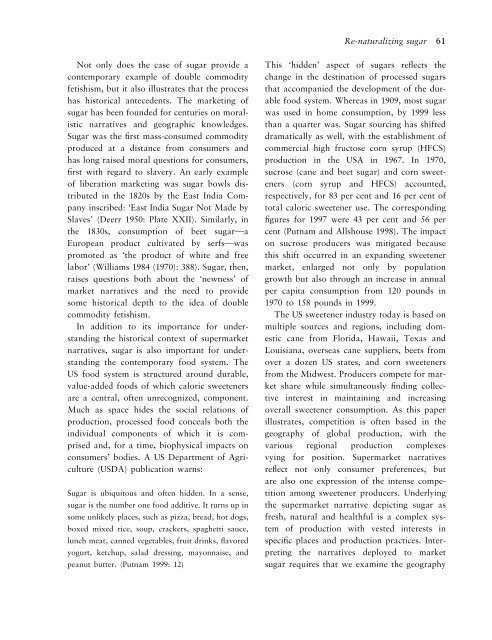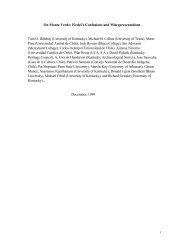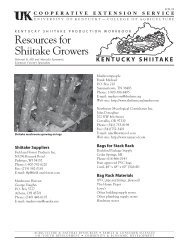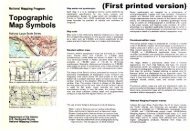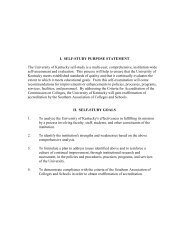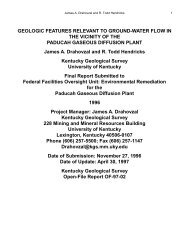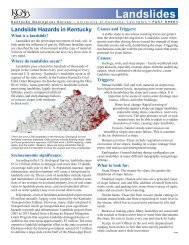Re-naturalizing sugar: narratives of place, production and ...
Re-naturalizing sugar: narratives of place, production and ...
Re-naturalizing sugar: narratives of place, production and ...
Create successful ePaper yourself
Turn your PDF publications into a flip-book with our unique Google optimized e-Paper software.
Not only does the case <strong>of</strong> <strong>sugar</strong> provide a<br />
contemporary example <strong>of</strong> double commodity<br />
fetishism, but it also illustrates that the process<br />
has historical antecedents. The marketing <strong>of</strong><br />
<strong>sugar</strong> has been founded for centuries on moralistic<br />
<strong>narratives</strong> <strong>and</strong> geographic knowledges.<br />
Sugar was the first mass-consumed commodity<br />
produced at a distance from consumers <strong>and</strong><br />
has long raised moral questions for consumers,<br />
first with regard to slavery. An early example<br />
<strong>of</strong> liberation marketing was <strong>sugar</strong> bowls distributed<br />
in the 1820s by the East India Company<br />
inscribed: ‘East India Sugar Not Made by<br />
Slaves’ (Deerr 1950: Plate XXII). Similarly, in<br />
the 1830s, consumption <strong>of</strong> beet <strong>sugar</strong>—a<br />
European product cultivated by serfs—was<br />
promoted as ‘the product <strong>of</strong> white <strong>and</strong> free<br />
labor’ (Williams 1984 (1970): 388). Sugar, then,<br />
raises questions both about the ‘newness’ <strong>of</strong><br />
market <strong>narratives</strong> <strong>and</strong> the need to provide<br />
some historical depth to the idea <strong>of</strong> double<br />
commodity fetishism.<br />
In addition to its importance for underst<strong>and</strong>ing<br />
the historical context <strong>of</strong> supermarket<br />
<strong>narratives</strong>, <strong>sugar</strong> is also important for underst<strong>and</strong>ing<br />
the contemporary food system. The<br />
US food system is structured around durable,<br />
value-added foods <strong>of</strong> which caloric sweeteners<br />
are a central, <strong>of</strong>ten unrecognized, component.<br />
Much as space hides the social relations <strong>of</strong><br />
<strong>production</strong>, processed food conceals both the<br />
individual components <strong>of</strong> which it is comprised<br />
<strong>and</strong>, for a time, biophysical impacts on<br />
consumers’ bodies. A US Department <strong>of</strong> Agriculture<br />
(USDA) publication warns:<br />
Sugar is ubiquitous <strong>and</strong> <strong>of</strong>ten hidden. In a sense,<br />
<strong>sugar</strong> is the number one food additive. It turns up in<br />
some unlikely <strong>place</strong>s, such as pizza, bread, hot dogs,<br />
boxed mixed rice, soup, crackers, spaghetti sauce,<br />
lunch meat, canned vegetables, fruit drinks, flavored<br />
yogurt, ketchup, salad dressing, mayonnaise, <strong>and</strong><br />
peanut butter. (Putnam 1999: 12)<br />
<strong>Re</strong>-<strong>naturalizing</strong> <strong>sugar</strong> 61<br />
This ‘hidden’ aspect <strong>of</strong> <strong>sugar</strong>s reflects the<br />
change in the destination <strong>of</strong> processed <strong>sugar</strong>s<br />
that accompanied the development <strong>of</strong> the durable<br />
food system. Whereas in 1909, most <strong>sugar</strong><br />
was used in home consumption, by 1999 less<br />
than a quarter was. Sugar sourcing has shifted<br />
dramatically as well, with the establishment <strong>of</strong><br />
commercial high fructose corn syrup (HFCS)<br />
<strong>production</strong> in the USA in 1967. In 1970,<br />
sucrose (cane <strong>and</strong> beet <strong>sugar</strong>) <strong>and</strong> corn sweeteners<br />
(corn syrup <strong>and</strong> HFCS) accounted,<br />
respectively, for 83 per cent <strong>and</strong> 16 per cent <strong>of</strong><br />
total caloric sweetener use. The corresponding<br />
figures for 1997 were 43 per cent <strong>and</strong> 56 per<br />
cent (Putnam <strong>and</strong> Allshouse 1998). The impact<br />
on sucrose producers was mitigated because<br />
this shift occurred in an exp<strong>and</strong>ing sweetener<br />
market, enlarged not only by population<br />
growth but also through an increase in annual<br />
per capita consumption from 120 pounds in<br />
1970 to 158 pounds in 1999.<br />
The US sweetener industry today is based on<br />
multiple sources <strong>and</strong> regions, including domestic<br />
cane from Florida, Hawaii, Texas <strong>and</strong><br />
Louisiana, overseas cane suppliers, beets from<br />
over a dozen US states, <strong>and</strong> corn sweeteners<br />
from the Midwest. Producers compete for market<br />
share while simultaneously finding collective<br />
interest in maintaining <strong>and</strong> increasing<br />
overall sweetener consumption. As this paper<br />
illustrates, competition is <strong>of</strong>ten based in the<br />
geography <strong>of</strong> global <strong>production</strong>, with the<br />
various regional <strong>production</strong> complexes<br />
vying for position. Supermarket <strong>narratives</strong><br />
reflect not only consumer preferences, but<br />
are also one expression <strong>of</strong> the intense competition<br />
among sweetener producers. Underlying<br />
the supermarket narrative depicting <strong>sugar</strong> as<br />
fresh, natural <strong>and</strong> healthful is a complex system<br />
<strong>of</strong> <strong>production</strong> with vested interests in<br />
specific <strong>place</strong>s <strong>and</strong> <strong>production</strong> practices. Interpreting<br />
the <strong>narratives</strong> deployed to market<br />
<strong>sugar</strong> requires that we examine the geography


